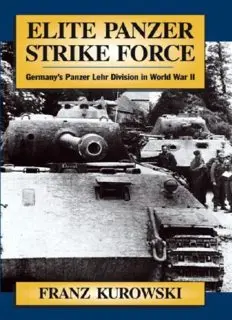
Elite Panzer Strike Force: Germany's Panzer Lehr Division in World War II PDF
Preview Elite Panzer Strike Force: Germany's Panzer Lehr Division in World War II
Franz Kurowski Acknowledgments ................................... iv Chapter 1 of the Division Chapter 2 Activation of the Division ............................. 6 Chapter 3 In Vienna and Budapest ............................. 12 Chapter 4 The March to the Front .............................. 25 Chapter 5 The Fighting for Tilly .................................. 39 Chapter 6 Days of Horror ..................................... 66 Chapter 7 A New Major Attack ................................. 80 Chapter 8 Westward ......................................... 87 Chapter 9 Hell ............................................. 106 Chapter 10 Retreat .......................................... 118 Chapter 11 At the Westwall and Beyond .......................... 159 Chapter 12 Victory Lost: The Fighting in the Ardennes ............. 169 Chapter 13 To the Bitter End .................................. 207 Appendices ........................................ 217 Select Bibliography ................................... 235 pecial thanks are in order for Generalleutnant Fritz Bayerlein, who provided his entire manuscript concerning the operations of the PLD. The division's veterans association helped clear up matters wherever there were discrepancies and placed me in contact with various veterans. of the core formations of the future Panzer-Lehr-Division was the Panzer-Lehr-Regiment, which had been established at the Armor School at Wiinsdorf (Berlin) in Elements of the regiment were attached to the 3. Panzer- Division for participation in the campaign in Elements of the regiment also participated in the campaign in the West in 1940. In the fall of 1940, the regiment consisted of the following three battalions: • 1st Battalion: Tank (1st through 4th Companies) • 2nd Battalion: Motorized Rifle (later Mechanized Infantry) (5th through 8th Companies) • 3rd Battalion: Antitank (9th through 12th Companies) In the summer of 1941, the regiment was again alerted for operations in the field, this time in the Soviet Union. The 1st Battalion was attached to an armored division. It was never decisively engaged, however, and returned to Wiznsdorf a few months later, after transferring its weapons and equipment to other forces in the field. Soon thereafter, the Lehr-Brigade 900 (mot.) was formed in East This formation was established using the 2nd Battalion of the Panzer-LehrRegiment, augmented by the 1st Battalion of the Infanterie-Lehr-Regiment Do'beritz of Oberst Muller-Bulow, one artillery battalion from the ArtillerieLehr-Regiment, a signals instructional company from Halle, and the medical instruction company in Berlin-Reinickendorf. Also assigned was a troop from the Aufkldrungs-Lehr- Abteilungin Krampnitz.4 The commander of this brigade was OberstWalther Krause. The brigade's tactical insignia was a tower with a Gothic "L," with the tower representing the tower at the National Playing Fields in Berlin. The brigade was completely motorized with both wheeled and tracked vehicles. None of the elements of this ad hoc formation had ever trained together before. On the day of its arrival in the Soviet Union, the brigade was partially committed. It advanced through Thorn and Suwalki in the direction of Vilna. It was employed in the pocket battles at Minsk, Lepel, Vitebsk and Smolensk. It was outside of Smolensk, along the Wopj, Wotija and Zarewitsch Rivers that the brigade was employed in its entirety, and it suffered heavy casualties as it screened against Soviet forces attempting to break out of the Smolensk Pocket to the northeast. There was heavy fighting in the Duchowtschina area. After three weeks of defensive fighting, it participated in the advance across the Beloj in the direction of Rshew. It was frequently thrown into the line when the Soviets attempted to break through the German main line of resistance with strong armored forces on 5 August. It was during that round of fighting that Unteroffizier Kintzel of the 2nd Company of Panzerjager-Lehr-Abteilung 900 was employed with his PaK 38, a 5-centimeter antitank gun, in one of the most threatened areas. He had just gone into position when the first Soviet T-34's and KV-I's came rolling up in attack. The antitank gunners opened fire at 800 meters. After two rounds, Kintzel's gun had knocked out the first T-34. In quick succession, two more T-34's suffered the same fate. Then, a KV-I appeared barely 200 meters off to the right. The gun turned to face the opponent, but it fired five rounds without effect, with the remaining enemy closing to within 50 meters in the meantime. Kintzel was able to observe one of his rounds penetrate cleanly through the turret of another T-34, but the weight of the Soviet attack proved too much for the infantry in the sector. Kintzel soon found himself and his crew alone. When the Soviet infantry closed in to assault, the gun had to be abandoned. Since there were no demolition charges available, the Soviets captured it intact, along with ten rounds of ammunition. The German lines were pushed back several hundred meters. Despite the setback, Kintzel was eventually awarded the Iron Cross, First Class, for his bravery in slowing down the Soviet onslaught in his sector. Following an intensive artillery preparation, the Soviets broke through in the sector of the 2nd Battalion of Infanterie-Regiment 56 in the Gorbatowsky area two days later, early on the morning of 8 August. Soon, the lead Soviet elements were three kilometers east of Lossewo. The brigade, which was serving as the
